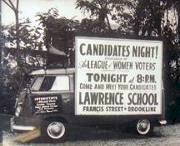
Women From Then to Now - The Story of Women's Suffrage
Share
“Men, their rights, and nothing more.
Women, their rights, and nothing less.”
- Susan B. Anthony
 This exhibit focuses on suffrage, and the women who helped secure that right for women to vote. From posters to cartoons to pins to binders, this exhibit uses many different methods to show the many different aspects of the female vote. A book on display, Madam President, as well as another pamphlet, talks about the possibility of having a woman president, while another picture and newspaper clipping shows Afghanistani women voting and discusses that process. This fun and entertaining exhibit contains much information on the women’s suffrage movement as a whole, as well as the individual members who participated. Also included in this exhibit is a talking-voting machine, used by blind people, with information about the Braille system and how it is used currently.
This exhibit focuses on suffrage, and the women who helped secure that right for women to vote. From posters to cartoons to pins to binders, this exhibit uses many different methods to show the many different aspects of the female vote. A book on display, Madam President, as well as another pamphlet, talks about the possibility of having a woman president, while another picture and newspaper clipping shows Afghanistani women voting and discusses that process. This fun and entertaining exhibit contains much information on the women’s suffrage movement as a whole, as well as the individual members who participated. Also included in this exhibit is a talking-voting machine, used by blind people, with information about the Braille system and how it is used currently.
The History of Women’s Suffrage
In 1995, the passage of the 19th amendment to the Constitution, giving women the right to vote, celebrated its 75th anniversary. The resolution calling for woman suffrage had passed, after much debate, at the Seneca Falls Convention in 1848, convened by Elizabeth Cady Stanton and Lucretia Mott. In The Declaration of Sentiments, a document based upon the Declaration of Independence, the numerous demands of these early activists were elucidated.
The 1848 convention had challenged America to social revolution that would touch every aspect of life. Early women's rights leaders believed suffrage to be the most effective means to change an unjust system. By the late 1800s, nearly fifty years of progress afforded women advancement in property rights, employment and educational opportunities, divorce and child custody laws, and increased social freedoms. The early 1900s saw a successful push for the vote through a coalition of suffragists, temperance groups, reform-minded politicians, and women's social welfare organizations.
Although Susan B. Anthony and Elizabeth Cady Stanton devoted 50 years to the woman's suffrage movement, neither lived to see women gain the right to vote. But their work and that of many other suffragists contributed to the ultimate passage of the 19th amendment in 1920. To put things into historical perspective, we've included a Womens Rights Timeline that chronicles the history of the women's rights movement.
Related: Influential Women in the Suffrage Movement
The League of Women Voters is an outgrowth of the suffragist movement. Carrie Chapman Catt founded the organization in 1920 during the convention of the National American Woman Suffrage Association. The convention was held only six months before the 19th amendment to the U.S. Constitution was ratified, giving women the right to vote after a 57-year struggle.
Today, that trust allows the League to continue to influence public policy. The League's impact is felt at all levels of government: local, state and national. The League's work is based on the belief that citizens who have well researched and unbiased information will make wise decisions for their communities and their nation. The League helps citizens ensure that their voices are heard at the local state and national levels and through coalition building around shared issues.
The League of Women Voters Education Fund takes action in local communities to support public policy issues. In 1998-99, the Kaiser Family Foundation has partnered with state and local Leagues around the country to bring the public voice on Medicare reform to the National Bipartisan Commission on the Future of Medicare. Though the commission ended in deadlock, the League found a remarkable citizen consensus on applying the core values of fairness, access, responsibility and efficiency to public policy options.
